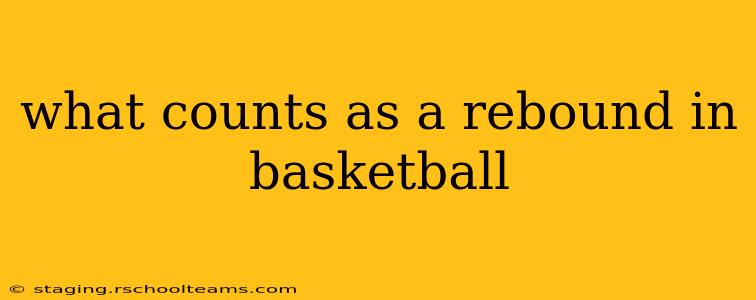In basketball, the battle for the boards is a crucial aspect of the game, often dictating the flow and outcome of a match. Understanding what constitutes a rebound is key to appreciating the skill and strategy involved. This guide will break down precisely what counts as a rebound, offering insights for players and fans alike.
Defining a Rebound: The Basics
A rebound in basketball occurs when a player gains possession of the ball after a missed shot. This seems straightforward, but there are nuances to consider. It's not just about catching the ball; it's about gaining control after the shot attempt.
Key Elements of a Rebound:
- Missed Shot: The shot must have been unsuccessful; a made basket doesn't result in a rebound.
- Gaining Control: The player must secure the ball, preventing the opposing team from gaining possession. A simple tap isn't enough; the player must have clear control, allowing them to pass, shoot, or dribble.
- Legal Possession: The player must gain possession within the boundaries of the court. A ball going out of bounds after a missed shot doesn't count as a rebound for anyone.
Types of Rebounds: Offensive vs. Defensive
Rebounds are further categorized into offensive and defensive rebounds, significantly impacting team strategy:
Offensive Rebound:
An offensive rebound occurs when a player on the shooting team secures the ball after their own team's missed shot. Offensive rebounds provide a second chance to score, extending possessions and putting pressure on the opposing team's defense. Securing offensive boards is a crucial skill for power forwards and centers.
Defensive Rebound:
A defensive rebound occurs when a player on the defending team gains possession of the ball after the opposing team's missed shot. Securing defensive rebounds prevents the opposing team from scoring a second chance, allowing the defending team to transition into their offense. This is a vital aspect of team defense and often crucial for maintaining control of the game.
Situations that Don't Count as Rebounds:
While the definition of a rebound seems clear-cut, certain situations don't qualify:
- A tipped ball that goes directly out of bounds: This results in possession for the opposing team but is not classified as a rebound.
- A steal after a missed shot: If a defender intercepts the ball before it hits the rim or backboard, it is considered a steal, not a rebound.
- A blocked shot that is controlled: A blocked shot that is subsequently caught or controlled by the blocking team is a blocked shot, not a rebound for the blocking team.
Mastering the Rebound: Technique and Strategy
Rebounding is a skill honed through practice and strategic positioning. Key elements include:
- Box Out: Establishing a strong position to prevent opposing players from reaching the ball.
- Timing: Anticipating where the ball will land based on the type of shot and the shooter's trajectory.
- Jumping Technique: Using proper technique for effective vertical leap and ball control.
- Teamwork: Coordinating with teammates to effectively box out and secure the rebound.
Understanding the nuances of what constitutes a rebound is crucial for both players and fans alike. This knowledge helps to fully appreciate the strategic importance of rebounding and the individual skill required to master the boards.
